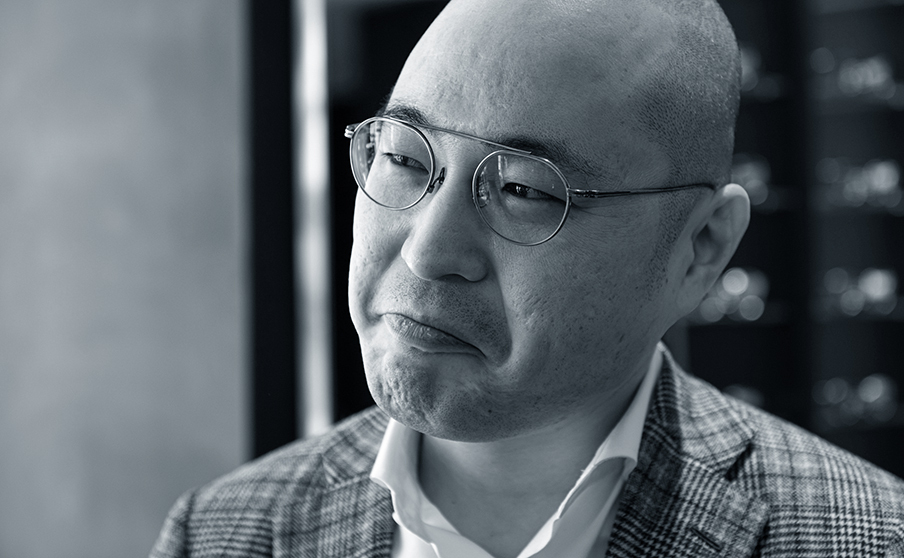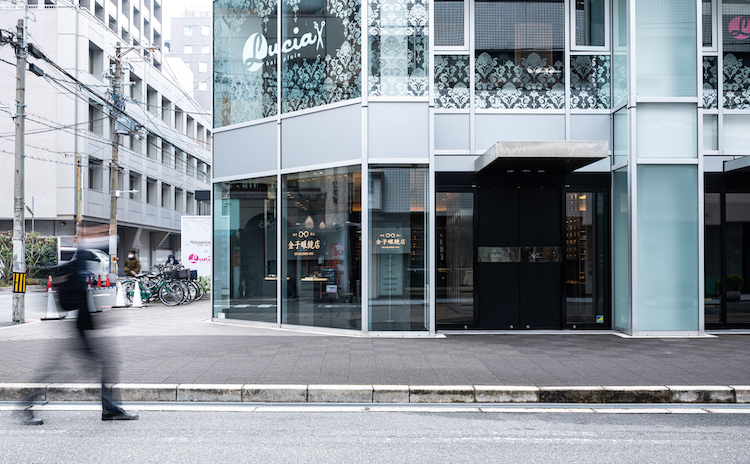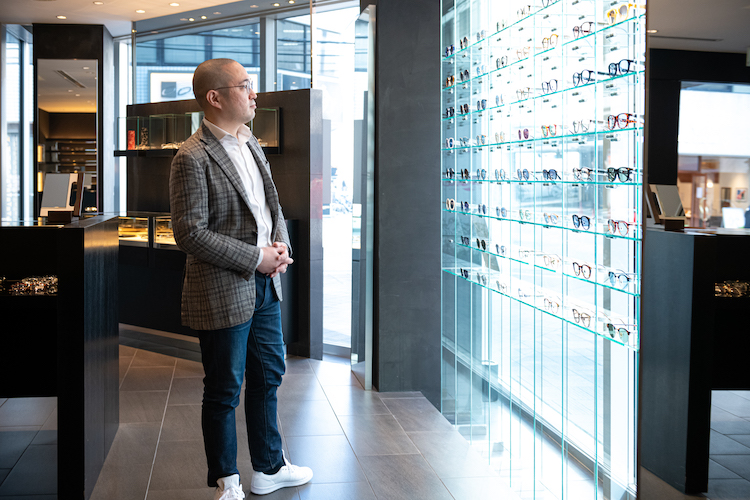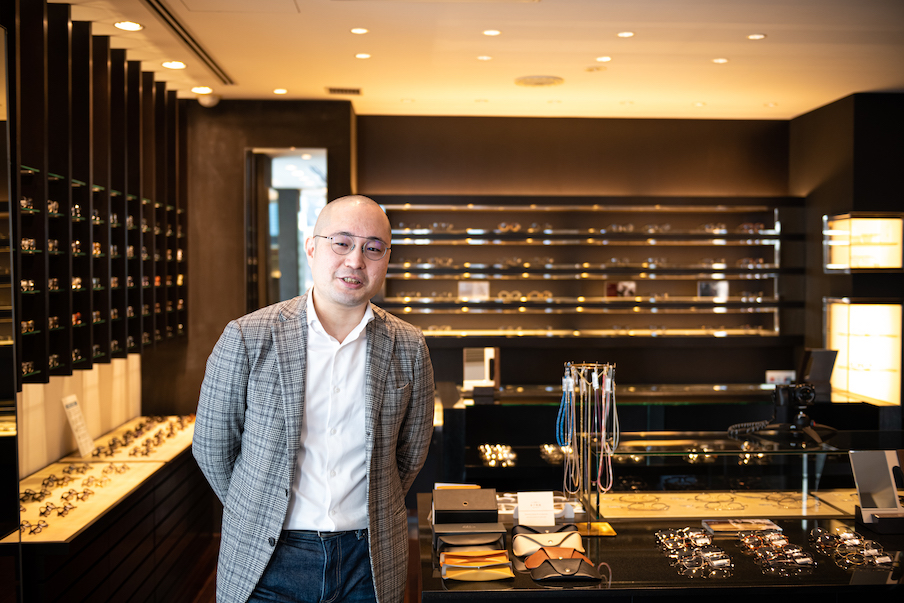Area Manager/
Manager of KANEKO GANKYO-TEN Minamisenba Branch and Grand Front Osaka Branch
Masaya Narita

Since childhood he has been repeatedly told “you are different” by those around him. It was that way when he became a student and again when he became an adult. “I had no such awareness at all, so I was always raising my eyebrow and wondering why they said this to me (laughs).” It's clearly not that he is "different." When faced with a choice, or forced to make a decision, his unwavering guiding principle is: "don't think with your head, follow your feelings" -- something that started to dawn on him as soon as he began to understand the world, and is no doubt what makes the people around him think he’s different. He's able do bold things many would secretly like to do, but in a natural and effortless way. That was the writer’s very first impression after our interview.
As area manager, Masaya Narita is currently store manager of both the KANKEKO OPTICAL Minami Senba store and the KANEKO OPTICAL Grand Front Osaka store.
Narita joined the company in March 2005, and is now in his 17th year. His peers describe him as "very fashionable, with strong preferences, and caring.” He was born in Tajimi City, Gifu Prefecture. He’s had a connection with glasses since his childhood, and in a unique way. “My uncle on my mother's side worked as an eyeglass designer. He started out at a manufacturer, but then he went freelance and always worked at home. Ever since I was a kid, when I would visit my uncle's house I would peek into his workshop and see samples of glasses he’d designed piled up everywhere. I started wearing glasses around my first year of junior high, so I got interested in the glasses themselves, and he would often give me some of those samples. Of course, they didn't have lenses, so when I saved up my New Year's money or allowance, I would go and get lenses put in, so I would have, like, three pairs of glasses even though I was just a junior high student (laughs). All of them were samples my uncle gave me though…”
Eventually, the boy became a young man and found he’d become a respectable eyeglass geek. After graduating from high school, Narita went on to a local university. It was about 40 minutes by JR train from Gifu to Nagoya Station, so whether he went for fun or for shopping, it was always to Nagoya. “When I was a college student, I spent more than half of the money I earned from my part-time job on glasses in Nagoya. I don't even know how much I spent (laughs).” This was from the late 1990s to the early 2000s, when a huge "eyewear boom" was taking place in Japan, with the emergence of many excellent designers and manufacturers and the appearance of select stores selling eyeglasses.
If you feel it, don't hesitate.
In his third year of college, he began his job search. Narita had majored in information processing. Naturally his job search was focused on the information industry, and he had a pretty good idea of where he wanted to work. Then one day he made one of his usual trips to Nagoya, and when got into a lively discussion about glasses with the staff in the first store he entered, someone said “Narita-san, why don’t you come work in the eyeglass industry?” No matter how much he had loved getting samples from his uncle as a kid, or spending his part-time earnings on glasses as a college student, it had never occurred to him to work in the eyeglasses industry.
But that one question from the shop staff person allowed him to imagine himself for the first time working in the eyeglass business. “That could be interesting…” He’d always acted honestly on what he felt; now he immediately changed his job search direction and decided to work for a local optician. Given his love of eyeglasses, he had a personal favorite store at the time: the COMPLEX Nagoya store in Sakae, KANEKO OPTICAL’s first outpost in Nagoya. To Narita, the store's product lineup was appealing, but it was even more the people who worked there that drew him. His encounter with Hideo Higashino, store manager at the time, would have a particularly important impact on Narita's life. After he had been working at the COMPLEX Nagoya store for some time, he got a call one day from Higashino. He wanted to see if Narita would be interested in working as opening staff at the new FACIAL INDEX NEW YORK Nagoya Store opening in Nagoya. “I was happy to be approached like that, but I had no complaints at all about where I was working at the time. I had just learned to how to work with order-made hearing aids, and was finding that work rewarding. But I heard from Higashino-san that this new store was going to open on the first floor of a department store... It was unusual at the time to have an optician on the first floor of a department store. I did think it sounded interesting, but at that point I had never seen a KANEKO OPTICAL store with a "FACIAL INDEX" sign, so I couldn’t really consider this until I could actually saw and feel what the store was like. On my next day off after Higashino approached me, I went up to Tokyo to see the shop in Marunouchi, and with the staff serving me, I had a pair of glasses made. I thought it was a very good store – both the store and the products. But more than that it was Higashino-san who really drew me. That was a great feeling to be asked directly by him. So on the bullet train home, I decided to change jobs." Narita made his way directly to the COMPLEX store after arriving in Nagoya station and told Higashino, simply, "I’m at your service.”
Don't think. Feel.
Thus Narita was welcomed as part of the initial staff for the new "FACIAL INDEX NEW YORK Nagoya," which was opened with great fanfare. He later heard that when Higashino had approached Narita about joining the company, president Shinya Kaneko had told him, "if you think he’s a good man, you are free to hire him.” So there was no interview when he joined the company. “There was no interview, and I never even wrote a resume (laughs). That would be impossible today, and even then it was impossible. It’s nice to be trusted!”
Narita was never the type to put a natural smile on his face and strike up a conversation with a stranger, and in his own mind he never thought he was suited to serve customers. For a while even his own relatives made fun of him: "I can't believe you’re in the customer service business,” etc. But he’d followed his feelings into the eyeglass industry, and he did learn to approach customers without hesitation, to the point where those above him would comment, “he’s fearless, isn’t he?” He’d once again dived into a new world, and his desire to polish his customer skills and deepen his understanding grew even stronger. For Narita, there’s no question that meant traveling out to all kinds of sites, receiving first class service, and “feeling it.”
When I thought about where I could find an example of high-level customer service, I guessed it would probably be at a luxury hotel. And one that’s been loved by its customers for a long time. A client I am personally close happened to worked at a hotel, so I spent some of my hard-earned money to experience some of that first-class customer service. I knew nothing would come from simply cogitating about what good customer service must be. As I actually started being served in various ways by the people working there and talked to them, I realized my understanding had been quite off. Until then, I thought the best service had to do with presentation and language, and the fine details of every move. But I found customer service was a very friendly thing. In a good sense, it was not stiff or formal. Everything was natural. That kind of customer service puts us at ease and feels comfortable. And when a person is able to provide that, there’s a sense that he or she may be able to respond my wishes, whatever the situation – that they are keeping an eye out for me and taking care. That’s what I felt was first-class customer service; that’s what makes them top-notch.” Narita's code of conduct, "Don't think with your head, just go with the feeling," is reminiscent of the legendary Bruce Lee’s words: "Don't think. Feel.” He has put that code into action in every aspect of his work, and it has helped him to grow in his chosen field of customer service.
“What makes me happy in this job is when a customer says something unexpected to me. One person said to me, ‘because of you, Narita-san, I now like glasses.’ They were being a little sarcastic (laughs). Another customer said, ‘the reason I always buy my glasses from this store is that the staff look so happy working here.’ I really think that is an important thing in creating a store. Coming to a store like ours to buy glasses is not part of people’s routine. This is not something you can experience at any old time. So it’s our job to make that time enjoyable. And to create that environment, I myself have to take the lead and enjoy my work. Some people may think, ‘Well, it's a job, so you can’t be having fun all the time,’ but I see it as quite the opposite. When I’m enjoying my work is exactly when the customers are going to enjoy their time with us.”
PROFILE
Masaya Narita
Born in Tajimi City, Gifu Prefecture. After graduating from a local university, worked at an optician shop. Joined KANEKO OPTICAL in 2005 as initial staff of "FACIAL INDEX NEW YORK Nagoya Store" after being approached by Hideo Higashino, then manager of COMPLEX Nagoya Store, where Narita had been a regular customer. As area manager, currently manages KANEKO OPTICAL Minami Senba Store and KANEKO OPTICAL Grand Front Osaka Store.




As area manager, Masaya Narita is currently store manager of both the KANKEKO OPTICAL Minami Senba store and the KANEKO OPTICAL Grand Front Osaka store.
Narita joined the company in March 2005, and is now in his 17th year. His peers describe him as "very fashionable, with strong preferences, and caring.” He was born in Tajimi City, Gifu Prefecture. He’s had a connection with glasses since his childhood, and in a unique way. “My uncle on my mother's side worked as an eyeglass designer. He started out at a manufacturer, but then he went freelance and always worked at home. Ever since I was a kid, when I would visit my uncle's house I would peek into his workshop and see samples of glasses he’d designed piled up everywhere. I started wearing glasses around my first year of junior high, so I got interested in the glasses themselves, and he would often give me some of those samples. Of course, they didn't have lenses, so when I saved up my New Year's money or allowance, I would go and get lenses put in, so I would have, like, three pairs of glasses even though I was just a junior high student (laughs). All of them were samples my uncle gave me though…”
Eventually, the boy became a young man and found he’d become a respectable eyeglass geek. After graduating from high school, Narita went on to a local university. It was about 40 minutes by JR train from Gifu to Nagoya Station, so whether he went for fun or for shopping, it was always to Nagoya. “When I was a college student, I spent more than half of the money I earned from my part-time job on glasses in Nagoya. I don't even know how much I spent (laughs).” This was from the late 1990s to the early 2000s, when a huge "eyewear boom" was taking place in Japan, with the emergence of many excellent designers and manufacturers and the appearance of select stores selling eyeglasses.